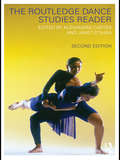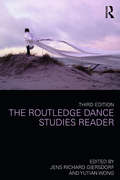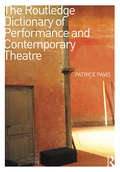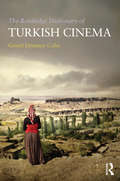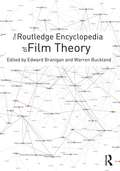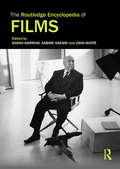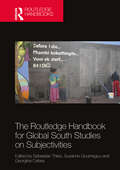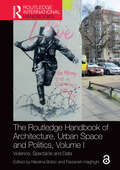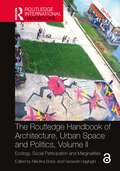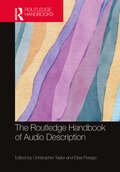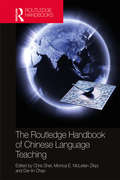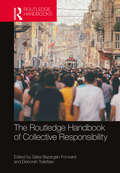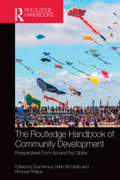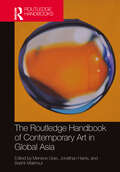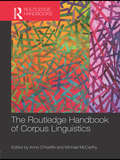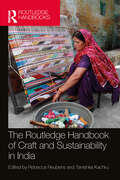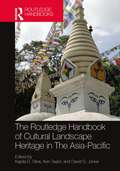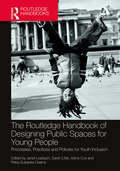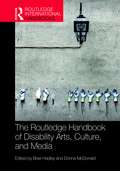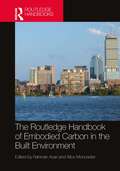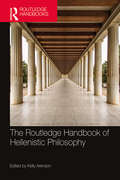- Table View
- List View
The Routledge Dance Studies Reader
by Janet O'Shea Alexandra CarterThe second edition of The Routledge Dance Studies Reader offers fresh critical perspectives on classic and modern dance forms, including ballroom, tango, Hip-hop, site-specific performance, and disability in dance. Alexandra Carter and Janet O'Shea deliver a substantially revised and updated collection of key texts, featuring an enlightening new introduction, which tracks differing approaches to dance studies. Important articles from the first edition are accompanied by twenty new works by leading critical voices. The articles are presented in five thematic sections, each with a new editorial introduction and further reading. Sections cover: Making dance Performing dance Ways of looking Locating dance in history and society Debating the discipline The Routledge Dance Studies Reader gives readers access to over thirty essential texts on dance and provides expert guidance on their critical context. It is a vital resource for anyone interested in understanding dance from a global and contemporary perspective.
The Routledge Dance Studies Reader
by Yutian Wong Jens Richard GiersdorfThe Routledge Dance Studies Reader has been expanded and updated, giving readers access to thirty-seven essential texts that address the social, political, cultural, and economic impact of globalization on embodiment and choreography. These interdisciplinary essays in dance scholarship consider a broad range of dance forms in relation to historical, ethnographic, and interdisciplinary research methods including cultural studies, reconstruction, media studies, and popular culture. This new third edition expands both its geographic and cultural focus to include recent research on dance from Southeast Asia, the People’s Republic of China, indigenous dance, and new sections on market forces and mediatization. Sections cover: Methods and approaches Practice and performance Dance as embodied ideology Dance on the market and in the media Formations of the field. The Routledge Dance Studies Reader includes essays on concert dance (ballet, modern and postmodern dance, tap, kathak, and classical khmer dance), popular dance (salsa and hip-hop), site-specific performance, digital choreography, and lecture-performances. It is a vital resource for anyone interested in understanding dance from a global and contemporary perspective.
The Routledge Dictionary of Performance and Contemporary Theatre
by Patrice PavisThe Routledge Dictionary of Contemporary Theatre and Performance provides the first authoritative alphabetical guide to the theatre and performance of the last 30 years. Conceived and written by one of the foremost scholars and critics of theatre in the world, it literally takes us from Activism to Zapping, analysing everything along the way from Body Art and the Flashmob to Multimedia and the Postdramatic. What we think of as 'performance' and 'drama' has undergone a transformation in recent decades. Similarly how these terms are defined, used and critiqued has also changed, thanks to interventions from a panoply of theorists from Derrida to Ranciere. Patrice Pavis's Dictionary provides an indispensible roadmap for this complex and fascinating terrain; a volume no theatre bookshelf can afford to be without.
The Routledge Dictionary of Turkish Cinema
by Gonul Donmez-ColinThe first critical and analytical dictionary of Turkish Cinema, this book provides a comprehensive overview of Turkish cinema from its beginnings to the present day. Addressing the lacuna in scholarly work on the topic, this dictionary provides immense detail on a wide range of aspects of Turkish cinema including; prominent filmmakers, films, actors, screenwriters, cinematographers, editors, producers, significant themes, genres, movements, theories, production modes, film journals, film schools and professional organizations. Extensively researched, elaborately detailed and written in a remarkably readable style, the Routledge Dictionary of Turkish Cinema will be invaluable for film scholars and researchers as a reference book and as a guide to the dynamics of the cinema of Turkey.
The Routledge Encyclopedia of Film Theory
by Warren Buckland Edward BraniganThe Routledge Encyclopedia of Film Theory is an international reference work representing the essential ideas and concepts at the centre of film theory from the beginning of the twentieth century, to the beginning of the twenty-first. When first encountering film theory, students are often confronted with a dense, interlocking set of texts full of arcane terminology, inexact formulations, sliding definitions, and abstract generalities. The Routledge Encyclopedia of Film Theory challenges these first impressions by aiming to make film theory accessible and open to new readers. Edward Branigan and Warren Buckland have commissioned over 50 scholars from around the globe to address the difficult formulations and propositions in each theory by reducing these difficult formulations to straightforward propositions. The result is a highly accessible volume that clearly defines, and analyzes step by step, many of the fundamental concepts in film theory, ranging from familiar concepts such as ‘Apparatus’, ‘Gaze’, ‘Genre’, and ‘Identification’, to less well-known and understood, but equally important concepts, such as Alain Badiou’s ‘Inaesthetics’, Gilles Deleuze’s ‘Time-Image’, and Jean-Luc Nancy’s ‘Evidence’. The Routledge Encyclopedia of Film Theory is an ideal reference book for undergraduates of film studies, as well as graduate students new to the discipline.
The Routledge Encyclopedia of Films
by John White Sarah Barrow Sabine HaenniThe Routledge Encyclopedia of Films comprises 200 essays by leading film scholars analysing the most important, influential, innovative and interesting films of all time. Arranged alphabetically, each entry explores why each film is significant for those who study film and explores the social, historical and political contexts in which the film was produced. Ranging from Hollywood classics to international bestsellers to lesser-known representations of national cinema, this collection is deliberately broad in scope crossing decades, boundaries and genres. The encyclopedia thus provides an introduction to the historical range and scope of cinema produced throughout the world.
The Routledge Handbook for Global South Studies on Subjectivities (Transdisciplinary Souths)
by Sebastian Thies Susanne Goumegou Georgina CebeyThe Routledge Handbook for Global South Studies on Subjectivities provides a series of exemplary studies conjoining perspectives from Asian, African, and Latin American Studies on subjectivity in the Global South as a central category of social and cultural analysis. The contestation of the Northern myth of the autonomous subject—the dispositive that contests subject formation in the South by describing it as fragmented, incomplete, delayed or simply deviant, has been a cornerstone of theory production from the South over the years.This volume’s contributions offer an interdisciplinary and transarea dialogue, reframing issues of selfhood and alterity, of personhood, of the human, of the commons and contesting the North’s presumption in determining what kind of subjectivities abide by its norms, whose voices are heard, who is recognised as a subject, and, by extension, whose lives matter. In the context of the shifting dynamics of today’s manifold crises, they raise questions regarding how subjectivities act on or resist such forms of contestation, contingency, and indeterminacy.A major contribution to the growing body of scholarship on the Global South, this handbook will be an essential resource for students, scholars, researchers and instructors in literature, media and culture studies, sociology, anthropology, philosophy, law, politics, visual arts and art history.
The Routledge Handbook of Architecture, Urban Space and Politics, Volume I: Violence, Spectacle and Data (Routledge International Handbooks)
by Nikolina Bobic and Farzaneh HaghighiFor architecture and urban space to have relevance in the 21st Century, we cannot merely reignite the approaches of thought and design that were operative in the last century. This is despite, or because of, the nexus between politics and space often being theorized as a representation or by-product of politics. As a symbol or an effect, the spatial dimension is depoliticized. Consequently, architecture and the urban are halted from fostering any systematic change as they are secondary to the event and therefore incapable of performing any political role. This handbook explores how architecture and urban space can unsettle the unquestioned construct of the spatial politics of governing. Considering both ongoing and unprecedented global problems – from violence and urban warfare, the refugee crisis, borderization, detention camps, terrorist attacks to capitalist urbanization, inequity, social unrest and climate change – this handbook provides a comprehensive and multidisciplinary research focused on the complex nexus of politics, architecture and urban space. Volume I starts by pointing out the need to explore the politics of spatialization to make sense of the operational nature of spatial oppression in contemporary times. The operative and active political reading of space is disseminated through five thematics: Violence and War Machines; Security and Borders; Race, Identity and Ideology; Spectacle and the Screen; and Mapping Landscapes and Big Data. This first volume of the handbook frames cutting-edge contemporary debates and presents studies of actual theories and projects that address spatial politics. This Handbook will be of interest to anyone seeking to meaningfully disrupt the reduction of space to an oppressive or neutral backdrop of political realities.
The Routledge Handbook of Architecture, Urban Space and Politics, Volume I: Violence, Spectacle and Data (Routledge International Handbooks)
by Nikolina Bobic and Farzaneh HaghighiFor architecture and urban space to have relevance in the 21st Century, we cannot merely reignite the approaches of thought and design that were operative in the last century. This is despite, or because of, the nexus between politics and space often being theorized as a representation or by-product of politics. As a symbol or an effect, the spatial dimension is depoliticized. Consequently, architecture and the urban are halted from fostering any systematic change as they are secondary to the event and therefore incapable of performing any political role. This handbook explores how architecture and urban space can unsettle the unquestioned construct of the spatial politics of governing.Considering both ongoing and unprecedented global problems – from violence and urban warfare, the refugee crisis, borderization, detention camps, terrorist attacks to capitalist urbanization, inequity, social unrest and climate change – this handbook provides a comprehensive and multidisciplinary research focused on the complex nexus of politics, architecture and urban space. Volume I starts by pointing out the need to explore the politics of spatialization to make sense of the operational nature of spatial oppression in contemporary times. The operative and active political reading of space is disseminated through five thematics: Violence and War Machines; Security and Borders; Race, Identity and Ideology; Spectacle and the Screen; and Mapping Landscapes and Big Data.This first volume of the handbook frames cutting-edge contemporary debates and presents studies of actual theories and projects that address spatial politics. This Handbook will be of interest to anyone seeking to meaningfully disrupt the reduction of space to an oppressive or neutral backdrop of political realities.Chapters 1 and 23 of this book are freely available as a downloadable Open Access PDF at http://www.taylorfrancis.com under a Creative Commons Attribution (CC-BY) 4.0 license.
The Routledge Handbook of Architecture, Urban Space and Politics, Volume II: Ecology, Social Participation and Marginalities (Routledge International Handbooks)
by Nikolina Bobic Farzaneh HaghighiArchitecture and the urban are connected to challenges around violence, security, race and ideology, spectacle and data. The first volume of this handbook extensively explored these oppressive roles. This second volume illustrates that escaping the corporatized and bureaucratized orders of power, techno-managerial and consumer-oriented capitalist economic models is more urgent and necessary than ever before. Herein lies the political role of architecture and urban space, including the ways through which they can be transformed and alternative political realities constituted. The volume explores the methods and spatial practices required to activate the political dimension and the possibility for alternative practices to operate in the existing oppressive systems while not being swallowed by these structures. Fostering new political consciousness is explored in terms of the following themes: Events and Dissidence; Biopolitics, Ethics and Desire; Climate and Ecology; Urban Commons and Social Participation; Marginalities and Postcolonialism. Volume II embraces engagement across disciplines and offers a wide range of projects and critical analyses across the so-called Global North and South. This multidisciplinary collection of 36 chapters provides the reader with an extensive resource of case studies and ways of thinking for architecture and urban space to become more emancipatory.Chapter 1 of this book is freely available as a downloadable Open Access PDF at http://www.taylorfrancis.com under a Creative Commons Attribution (CC-BY) 4.0 license.
The Routledge Handbook of Audio Description (Routledge Handbooks in Translation and Interpreting Studies)
by Christopher Taylor Elisa PeregoThis Handbook provides a comprehensive overview of the expanding field of audio description, the practice of rendering the visual elements of a multimodal product such as a film, painting, or live performance in the spoken mode, for the benefit principally of the blind and visually impaired community. This volume brings together scholars, researchers, practitioners and service providers, such as broadcasters from all over the world, to cover as thoroughly as possible all the theoretical and practical aspects of this discipline. In 38 chapters, the expert authors chart how the discipline has become established both as an important professional service and as a valid academic subject, how it has evolved and how it has come to play such an important role in media accessibility. From the early history of the subject through to the challenges represented by ever-changing technology, the Handbook covers the approaches and methodologies adopted to analyse the “multimodal” text in the constant search for the optimum selection of the elements to describe. This is the essential guide and companion for advanced students, researchers and audio description professionals within the more general spheres of translation studies and media accessibility.
The Routledge Handbook of Australian Urban and Regional Planning
by Neil Sipe and Karen VellaWhere is planning in twenty-first-century Australia? What are the key challenges that confront planning? What does planning scholarship reveal about the state of planning practice in meeting the needs of urban and regional Australians? The Routledge Handbook of Australian Urban and Regional Planning includes 27 chapters that answer these and many other questions that confront planners working in urban and regional areas in twenty-first-century Australia. It provides a single source for cutting edge thinking and research across a broad range of the most important topics in urban and regional planning. Divided into six parts, this handbook explores: contexts of urban and regional planning in Australia critical debates in Australian planning planning policy climate change, disaster risk and environmental management engaging and taking planning action planning education and research This handbook is a valuable resource for advanced undergraduate and postgraduate students in urban planning, built environment, urban studies and public policy as well as academics and practitioners across Australia and internationally.
The Routledge Handbook of Catalysts for a Sustainable Circular Economy (Routledge Environment and Sustainability Handbooks)
by Ari Jokinen Hanna Lehtimäki Leena Aarikka-Stenroos Pekka JokinenThis groundbreaking handbook leads the way in accelerating the transition to a sustainable circular economy by introducing the concept of a catalyst as a positive and enhancing driving force for sustainability. Catalysts create and maintain favourable conditions for complex systemic sustainability transition changes, and a discussion and understanding of catalysts is required to move from a linear economy to a sustainable and circular economy. With contributions from leading experts from around the globe, this volume presents theoretical insights, contextualised case studies, and participatory methodologies, which identify different catalysts, including technology, innovation, business models, management and organisation, regulation, sustainability policy, product design, and culture. The authors then show how these catalysts accelerate sustainability transitions. As a unique value to the reader, the book brings together public policy and private business perspectives to address the circular economy as a systemic change. Its theoretical and practical perspectives are coupled with real-world case studies from Finland, Italy, China, India, Nigeria, and others to provide tangible insights on catalysing the circular economy across organisational, hierarchical, and disciplinary boundaries. With its broad interdisciplinary and geographically diverse scope, this handbook will be a valuable tool for researchers, academics, and policy-makers in the fields of circular economy, sustainability transitions, environmental studies, business, and the social sciences more broadly.
The Routledge Handbook of Catalysts for a Sustainable Circular Economy (Routledge Environment and Sustainability Handbooks)
by Ari Jokinen Hanna Lehtimäki Leena Aarikka-Stenroos Pekka JokinenThis groundbreaking handbook leads the way in accelerating the transition to a sustainable circular economy by introducing the concept of a catalyst as a positive and enhancing driving force for sustainability. Catalysts create and maintain favourable conditions for complex systemic sustainability transition changes, and a discussion and understanding of catalysts is required to move from a linear economy to a sustainable and circular economy.With contributions from leading experts from around the globe, this volume presents theoretical insights, contextualised case studies, and participatory methodologies, which identify different catalysts, including technology, innovation, business models, management and organisation, regulation, sustainability policy, product design, and culture. The authors then show how these catalysts accelerate sustainability transitions. As a unique value to the reader, the book brings together public policy and private business perspectives to address the circular economy as a systemic change. Its theoretical and practical perspectives are coupled with real-world case studies from Finland, Italy, China, India, Nigeria, and others to provide tangible insights on catalysing the circular economy across organisational, hierarchical, and disciplinary boundaries.With its broad interdisciplinary and geographically diverse scope, this handbook will be a valuable tool for researchers, academics, and policy-makers in the fields of circular economy, sustainability transitions, environmental studies, business, and the social sciences more broadly.The Open Access version of this book, available at http://www.taylorfrancis.com, has been made available under a Creative Commons Attribution-Non Commercial-No Derivatives (CC-BY-NC-ND) 4.0 license.
The Routledge Handbook of Chinese Language Teaching
by Der-Lin Chao Chris Shei Monica E McLellan ZikpiThe Routledge Handbook of Chinese Language Teaching defines Chinese language teaching in a pedagogical, historical, and contemporary context. Throughout the volume, teaching methods are discussed, including the traditional China-based approach, and Western methods such as communicative teaching and the immersion program. The Handbook also presents a pedagogical model covering pronunciation, tones, characters, vocabulary, grammar, and the teaching of listening, speaking, reading, and writing. The remaining chapters explore topics of language assessment, technology enhanced instruction, teaching materials and resources, Chinese for specific purposes, classroom implementation, social contexts of language teaching and language teaching policies, and pragmatics and culture. Ideal for scholars and researchers of Chinese language teaching, the Handbook will benefit educators and teacher training programs. This is the first comprehensive volume exploring the growing area of Chinese language pedagogy.
The Routledge Handbook of Collective Responsibility (Routledge Handbooks in Philosophy)
by Bazargan-Forward, Saba / Tollefsen, DeborahThe Routledge Handbook of Collective Responsibility comprehensively addresses questions about who is responsible and how blame or praise should be attributed when human agents act together. Such questions include: Do individuals share responsibility for the outcome or are individuals responsible only for their contribution to the act? Are individuals responsible for actions done by their group even when they don’t contribute to the outcome? Can a corporation or institution be held morally responsible apart from the responsibility of its members? The Handbook’s 35 chapters—all appearing here for the first time and written by an international team of experts—are organized into four parts:Part I: Foundations of Collective ResponsibilityPart II: Theoretical Issues in Collective ResponsibilityPart III: Domains of Collective ResponsibilityPart IV: Applied Issues in Collective ResponsibilityEach part begins with a short introduction that provides an overview of issues and debates within that area and a brief summary of its chapters. In addition, a comprehensive index allows readers to better navigate the entirety of the volume’s contents. The result is the first major work in the field that serves as an instructional aid for those in advanced undergraduate courses and graduate seminars, as well as a reference for scholars interested in learning more about collective responsibility.
The Routledge Handbook of Community Development: Perspectives from Around the Globe
by Rhonda Phillips Sue Kenny Brian McGrathThe Routledge Handbook of Community Development explores community development theory and practice across the world. The book provides perspectives about community development as an interactive, relevant and sometimes contradictory way to address issues impacting the human condition. It promotes better understanding of the complexities and challenges in identifying, designing, implementing and evaluating community development constructs, applications and interventions. This edited volume discusses how community development is conceptualized as an approach, method or profession. Themes provide the scope of the book, with projects, issues or perspectives presented in each of these areas. This handbook provides invaluable contextualized insights on the theory and practice of community development around core themes relevant in society. Each chapter explores and presents an issue, perspectives, project or case in the thematic areas, with regional and country context included. It is a must-read for students and researchers working in community development, planning and human geography and an essential reference for any professional engaged in community development.
The Routledge Handbook of Contemporary Art in Global Asia
by Jonathan Harris Menene Gras Bashir MakhoulThis substantial collection of newly commissioned essays presents an ambitious, entertaining, and accessible guide to developments in Asian art over the past 20 years of the epoch of globalization. The term ‘global Asia’ signals the genesis and evolution of contemporary art within the context of global economic, social, political, and intellectual change related to the end of the Cold War, decolonization, the emergence of postcolonial societies and cultures, and the rise of a global contemporary art world. In the handbook its editors establish, in an extended introductory section and in four section introductions, the theoretical, geographical, and historical parameters within which the contemporary visual arts of ‘global Asia’ may be described, analyzed, and evaluated. The collected chapters provide a diverse, multiauthored, heterogeneous, and genuinely plural account of art and its contexts. The democratic and inclusive character of globalization is reflected and produced within this anthology, which includes different styles of writing as well as varieties of analytic and thematic focus. The anthology will appeal to both scholars and students in art history, art practice, curation, contemporary art, fine art, cultural studies, and globalization studies.
The Routledge Handbook of Corpus Linguistics (Routledge Handbooks in Applied Linguistics)
by Anne O’KeeffeThe Routledge Handbook of Corpus Linguistics provides a timely overview of a dynamic and rapidly growing area with a widely applied methodology. Through the electronic analysis of large bodies of text, corpus linguistics demonstrates and supports linguistic statements and assumptions. In recent years it has seen an ever-widening application in a variety of fields: computational linguistics, discourse analysis, forensic linguistics, pragmatics and translation studies. Bringing together experts in the key areas of development and change, the handbook is structured around six themes which take the reader through building and designing a corpus to using a corpus to study literature and translation. A comprehensive introduction covers the historical development of the field and its growing influence and application in other areas. Structured around five headings for ease of reference, each contribution includes further reading sections with three to five key texts highlighted and annotated to facilitate further exploration of the topics. The Routledge Handbook of Corpus Linguistics is the ideal resource for advanced undergraduates and postgraduates.
The Routledge Handbook of Craft and Sustainability in India
by Rebecca Reubens Tanishka KachruTraditional crafts have been an essential part of Indian history, culture and life. This handbook looks at craft as both a cultural artefact that reflects people’s worldviews, indigenous practices and traditions, as well as a source of income generation and development that is inclusive. India’s rapid development has meant a breakdown of traditional economies, and including craft production-to-consumption systems. Meanwhile, there is a call to action from different factions to protect, revive and reinvent craft, because the inherent sustainability of the systems that underpin it are essential for the sustainability of India and her people. Against this backdrop, this book examines the current landscape of craft in India—its production and marketing in different parts of India, the incorporation of innovation and technology, the push for sustainability and equitability in the handicraft ecosystem and promising government policies that have proved beneficial for craftspeople. It also discusses various challenges that artisans, micro-entrepreneurs, and marketers face working in the space. With contributions from leading experts in the field of design, activism, policy, education, cultural heritage and entrepreneurship, this volume provides a comprehensive and in-depth picture of the history, economics and future of craft and its relationship with sustainability.An authoritative resource on Indian craft, this handbook will be useful for scholars and researchers of sustainable development, development studies, architecture, design, heritage studies, cultural studies, political economy and public policy.
The Routledge Handbook of Cultural Landscape Heritage in The Asia-Pacific (Routledge Handbooks on Museums, Galleries and Heritage)
by Ken Taylor Kapila D. Silva David S. JonesThe Routledge Handbook of Cultural Landscape Heritage in the Asia-Pacific revisits the use, growth, and potential of the cultural landscape methodology in the conservation and management of culture-nature heritage in the Asia-Pacific region. Taking both a retrospective and prospective view of the management of cultural heritage in the region, this volume argues that the plurality and complexity of heritage in the region cannot be comprehensively understood and effectively managed without a broader conceptual framework like the cultural landscape approach. The book also demonstrates that such an approach facilitates the development of a flexible strategy for heritage conservation. Acknowledging the effects of rapid socio-economic development, globalization, and climate change, contributors examine the pressure these issues place on the sustenance of cultural heritage. Including chapters from more than 20 countries across the Asia-Pacific region, the volume reviews the effectiveness of theoretical and practical potentials afforded by the cultural landscape approach and examines how they have been utilized in the Asia-Pacific context for the last three decades. The Routledge Handbook of Cultural Landscape Heritage in the Asia-Pacific provides a comprehensive analysis of the processes of cultural landscape heritage conservation and management. As a result, it will be of interest to academics, students, and professionals who are based in the fields of cultural heritage management, architecture, urban planning, landscape architecture, and landscape management.
The Routledge Handbook of Designing Public Spaces for Young People: Processes, Practices and Policies for Youth Inclusion
by Janet Loebach Sarah Little Adina Cox Patsy Eubanks OwensThe Routledge Handbook of Designing Public Spaces for Young People is a thorough and practical resource for all who wish to influence policy and design decisions in order to increase young people’s access to and use of public spaces, as well as their role in design and decision-making processes. The ability of youth to freely enjoy public spaces, and to develop a sense of belonging and attachment to these environments, is critical for their physical, social, cognitive, and emotional development. Young people represent a vital citizen group with legitimate rights to occupy and shape their public environments, yet they are often driven out of public places by adult users, restrictive bylaws, or hostile designs. It is also important that children and youth have the opportunity to genuinely participate in the planning of public spaces, and to have their needs considered in the design of the public realm. This book provides both evidence and tools to help effectively advocate for more youth-inclusive public environments, as well as integrate youth directly into both research and design processes related to the public realm. It is essential reading for researchers, design and planning professionals, community leaders, and youth advocates.
The Routledge Handbook of Disability Arts, Culture, and Media
by Bree Hadley Donna McDonaldIn the last 30 years, a distinctive intersection between disability studies – including disability rights advocacy, disability rights activism, and disability law – and disability arts, culture, and media studies has developed. The two fields have worked in tandem to offer critique of representations of disability in dominant cultural systems, institutions, discourses, and architecture, and develop provocative new representations of what it means to be disabled. Divided into 5 sections: Disability, Identity, and Representation Inclusion, Wellbeing, and Whole-of-life Experience Access, Artistry, and Audiences Practices, Politics and the Public Sphere Activism, Adaptation, and Alternative Futures this handbook brings disability arts, disability culture, and disability media studies – traditionally treated separately in publications in the field to date – together for the first time. It provides scholars, graduate students, upper level undergraduate students, and others interested in the disability rights agenda with a broad-based, practical and accessible introduction to key debates in the field of disability art, culture, and media studies. An internationally recognised selection of authors from around the world come together to articulate the theories, issues, interests, and practices that have come to define the field. Most critically, this book includes commentaries that forecast the pressing present and future concerns for the field as scholars, advocates, activists, and artists work to make a more inclusive society a reality.
The Routledge Handbook of Embodied Carbon in the Built Environment
by Alice Moncaster Rahman AzariThis handbook explores the critically important topic of embodied carbon, providing advanced insights that focus on measuring and reducing embodied carbon from across the built environment, including buildings, urban areas and cities, and construction materials and components. Split into five distinct sections, international experts, researchers, and professionals present the recent developments in the field of embodied carbon from various perspectives and at different scales of material, building, and city. Following an introduction to the embodied carbon question, the chapters in Section 1 then cover the key debates around issues such as the politics of embodied carbon, links between embodied carbon and thermal mass, and the misuse of carbon offsets. Section 2 reviews the embodied carbon policies in a selected number of countries. Sections 3, 4, and 5 approach the topic of embodied carbon from urban-, building-, and material-scale perspectives, respectively, and use case studies to demonstrate estimation techniques and present opportunities and challenges in embodied carbon mitigation. This will be important reading for upper-level students and researchers in Architecture, Urban Planning, Engineering, and Construction disciplines. Presenting case studies of embodied carbon assessment, this book will also help practicing architects, engineers, and urban planners understand embodied carbon estimation techniques and different mitigation strategies.
The Routledge Handbook of Hellenistic Philosophy (Routledge Handbooks in Philosophy)
by Kelly ArensonHellenistic philosophy concerns the thought of the Epicureans, Stoics, and Skeptics, the most influential philosophical groups in the era between the death of Alexander the Great (323 BCE) and the defeat of the last Greek stronghold in the ancient world (31 BCE). The Routledge Handbook of Hellenistic Philosophy provides accessible yet rigorous introductions to the theories of knowledge, ethics, and physics belonging to each of the three schools, explores the fascinating ways in which interschool rivalries shaped the philosophies of the era, and offers unique insight into the relevance of Hellenistic views to issues today, such as environmental ethics, consumerism, and bioethics. Eleven countries are represented among the Handbook’s 35 authors, whose chapters were written specifically for this volume and are organized thematically into six sections: The people, history, and methods of Epicureanism, Stoicism, and Skepticism. Earlier philosophical influences on Hellenistic thought, such as Aristotle, Socrates, and Presocratics. The soul, perception, and knowledge. God, fate, and the primary principles of nature and the universe. Ethics, political theory, society, and community. Hellenistic philosophy’s relevance to contemporary life. Spanning from the ancient past to the present, this Handbook aims to show that Hellenistic philosophy has much to offer all thinking people of the twenty-first century.
